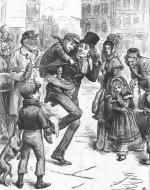Created by Victoria Smith on Tue, 07/27/2021 - 14:35
Description:
Introduction
Charles Dickens's 1843 novella A Christmas Carol features some of his most memorable characters: Ebenezer Scrooge, the book's miserly protagonist; the ghosts of Christmas Past, Present, and Future; and Tiny Tim, the son of Scrooge's impoverished employee, Bob Cratchit. This exhibit focuses on Tiny Tim -- a character who does not appear frequently in the text but who plays a vital role in Scrooge's repentance and moral awakening. Tiny Tim is remembered for his failing health, his small crutch, and his line "God Bless us every one!" (Dickens 47).
Martha Stoddard Holmes uses Tiny Tim's heartfelt plea to open her book Fictions of Affliction: Physical Disability in Victorian Culture, arguing that "whether we see him as touching or maudlin, the emotionality of our responses to Tiny Tim may seem normal and natural. If we identify ourselves as able-bodied people, the narrow range of emotions the character evokes may also feel more natural, or at least more comfortable, than our responses to the people with actual disabilities who share our world, who might spark a complex mix of surprise, sadness, curiosity, longing, irritation, uncertainty, boredom, identification, excitement, worry, fascination, love, collegiality, or any number of other feelings beyond the simple tonics of pity, laughter, terror, or anger" (2). Tim, Holmes argues, is a character whose simplified representation of disability elicits simplified feelings from readers -- and, later, viewers, as A Christmas Carol has been adapted over and over again since the book's publication. What are the consequences of these representations of disability?
The following images are an exploration of that question. These five images include iterations of Tiny Tim from the page, the stage, and the screen (big and small) and span over 175 years, beginning with John Leech's illustrations for Dickens's original publication and ending in BBC One's televised adaptation, written by Stephen Knight and aired in December 2019. Click through to see how illustrators, actors, and adapters have imagined Tiny Tim, and how they have represented his disability, over the decades.
Works Cited
Dickens, Charles. A Christmas Carol.
Holmes, Martha Stoddard. Fictions of Affliction: Physical Disability in Victorian Culture. University of Michigan Press, 2004.
Images in the Series
Fig. 1. Barnard, Fred. "He had been Tim's blood-horse all the way from church, and had come home rampant." Victorian Web, https://victorianweb.org/art/illustration/barnard/xmas/1.html, accessed Aug. 2, 2021.
Frank Barnard was an early illustrator of Dickens’s A Christmas Carol; this image was included in an edition of the novel published in the 1870s. Therefore, it’s a useful gauge of how Victorian readers would visualize Tiny Tim as a character with a disability. I noticed two things about this image’s depiction of Tim. First, the image includes not only Tim and his father, Bob Cratchit, who carries Tim on his back, but also a number of other people as part of an urban scene. The illustration includes three children standing around the central pair, and the boy in the front left of the image in particular — with his strong, straight legs—makes Tiny Tim’s frail legs all the more noticeable. In other words, by illustrating a community that includes children without visible disabilities, Barnard might make Tiny Tim’s disability seem like a deviation from typical childhood. Second, Tiny Tim looks directly outward from the image, confronting the reader with his frank gaze. He is the only character doing so, and his stare challenges the viewer to look back and engage him as a central character. While some depictions of Tiny Tim suggest that he is a frail and passive character, this seems to suggest that he does have some power — at least over the reader.
Fig. 2. Smith, Jessie Willcox. "Tiny Tim and Bob Cratchit on Christmas Day," Dickens's Children, Charles Scribers Sons, 1912. Project Gutenberg, https://www.gutenberg.org/files/32372/32372-h/32372-h.htm, accessed August 2, 2021.
Jessie Willcox Smith was an illustrator known for sentimental images of children, and this image is part of a collection of ten drawings by Smith of young characters in Dickens. Tiny Tim is the first and followed by characters such as David Copperfield, Little Nell, Oliver Twist, and the Artful Dodger. Each image is accompanied by a passage from the text in which the character appears. Tiny Tim and Bob Cratchit, for example, are pictured alongside the following: “In came little Bob, the father, with at least three feet of comforter exclusive of the fringe, hanging down before him; and his threadbare clothes darned up and brushed, to look seasonable; and Tiny Tim upon his shoulder.” Smith’s depiction of Tiny Tim includes many of the details that often seem associated with ideal childhood—rosy cheeks, blond hair—but his face is a little forlorn, and his crutch is featured prominently in the image, clutched by Tim across his father’s body. The illustration, as a whole, suggests Tiny Tim’s vulnerability and his reliance on his father. This image is also featured on the cover of Willcox’s book, suggesting that Tim is perhaps the quintessential Dickensian child, and in fact a number of the children in the book’s pages include images of children in states of dependence: Paul Dombey, for example, in his wheelchair at the beach.
Fig. 3. Tullo, Vincent. "Jai Ram Srinivasan (left) and Sebastian Ortiz alternate in the role of Tiny Tim in a new production of “A Christmas Carol” on Broadway," in Michael Paulson, "Rethinking Tiny Tim: Should a Disabled Actor Play the Role?" New York Times, 14 November 2019, https://www.nytimes.com/2019/11/13/theater/tiny-tim-a-christmas-carol-di..., accessed August 2, 2021.
This photograph features two Tiny Tims who might not immediately meet the viewers’ expectations of that character. The actors in the image, Jai Ram Srinivasan (left) and Sebastian Ortiz, alternated starring as Tiny Tim on Broadway in 2019, and the accompanying article by Michael Paulson for The New York Times describes a number of productions across the country in which Tiny Tim has been played by both boys and girls with a range of disabilities, such as Paris Strickland, an 11-year-old girl whose spine was compressed due to a neuroblastoma diagnosed when she was an infant, and Jonathan Rizzo, as 12-year-old boy with muscular dystrophy. Many of the casting directors Paulson interviews state that actors with disability provide an authenticity to the depiction of Tiny Tim that other actors simply would be unable to provide while tempering some of the more saccharine or problematic elements of the character as outlined by Dickens. They also make clear that it is important to represent people with disabilities on stage and to provide actors with disabilities much-needed opportunities. For example, Paulson quotes Jack Thorne, a Tony Award-winning playwright, who confessed, “One of my bugbears with ‘Christmas Carol’ is when Tiny Tim is not played by a disabled person, because he’s supposed to be a disabled character . . . When there’s a shortage of parts for people with disabilities,” he said, “it’s really important we have disabled people play disabled parts.” I think it is important to note, too, that Paulson’s article and the photograph of Srinivasan and Ortiz, as well as other actors who have played this role, suggest that contemporary productions of A Christmas Carol also have diversified our understanding of this memorable character in terms of gender, race, and ethnicity.
Fig. 4. Still of Lenny Rush and Guy Pierce as Tiny Tim from the trailer for BBC One's 2019 television series adaptation. BBC One, https://www.bbc.co.uk/programmes/p07xkf80, accessed 2 June 2021.
This still from BBC One’s 2019 adaptation of A Christmas Carol features one of the more unusual depictions of Tiny Tim, in this case played by Lenny Rush opposite Guy Pierce as Scrooge. (Rush played Tiny Tim at the Old Vic theater's production of A Christmas Carol, adapted by Jack Thorne, mentioned in my previous caption.) Tiny Tim, ice skating with his family, has plunged through the ice, and through the series’ surrealist visual effects, the bitter Scrooge, alone and far away, has a vision of the moment projected onto the ceiling of his office. Throughout this adaptation, Tiny Tim's vulnerability is depicted as a direct consequence of Scrooge’s parsimony and cruelty. As a whole, the adaptation focuses on and dives deeper into events in Scrooge’s past that have resulted in his bad character, and in some ways Tiny Tim is a vehicle through which Scrooge comes to terms with his own failings. This is true of Dickens’s novel, to a point, but this scene seems to emphasize that Tim is, here quite literally, a projection of Scrooge’s bad decisions—a sort of cautionary hallucination. That reading of Rush's Tiny Tim is in tension with his virtuoso as an actor...





